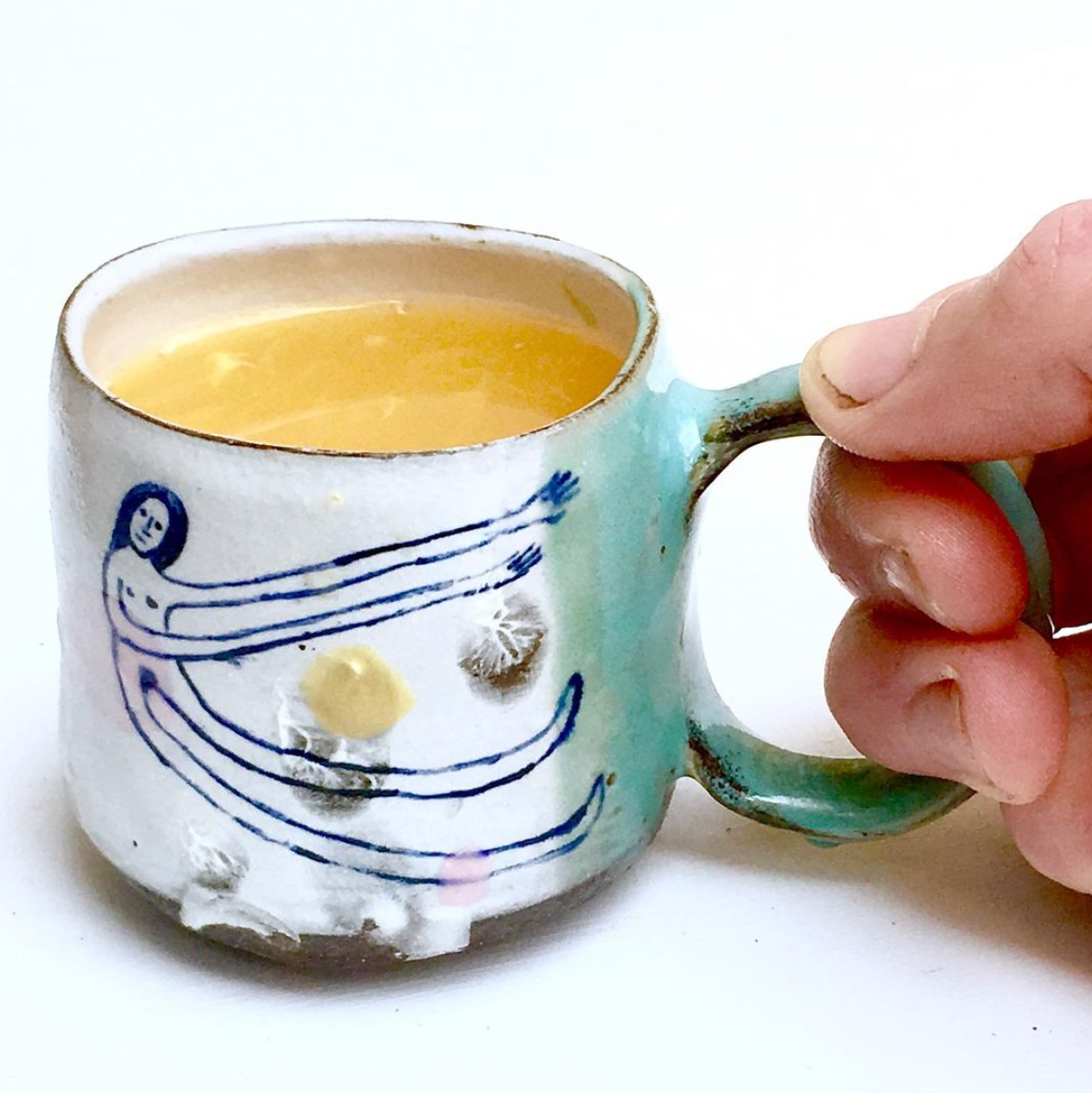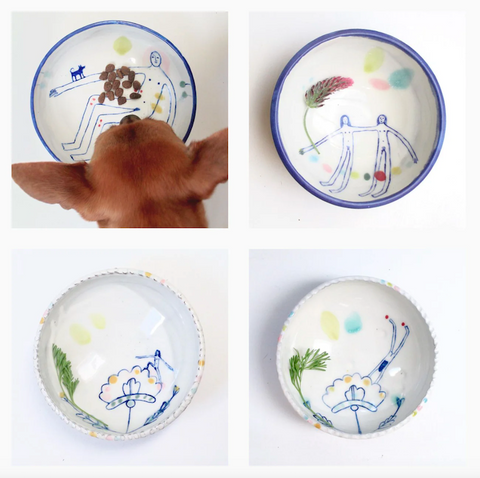Emelia Hiltner's Ceramics of Joy

What’s your personal and artistic background?
Like many potters, likely like many people, I was introduced to clay at a young age — by making mud pies in our backyard. Our Ohio soil had a high clay content, so forms could raise into vessels. My child brain thought that if I made my pots a cozy shelter out of sticks, and left them there to harden, that they’d dry out to a usable stage. Well, not quite!

Fast-forward to high school art class, where my teacher gave me free reign on a janky old kickwheel. The wheel was stashed in a corner of the room that felt like my very own in which to retreat, and though I can’t say any great work came out of there (it was the beginning of a long and arduous struggle learning to throw), it was the first step on my serious clay journey.

Around that time, my dad met a local ceramicist, Sheila Tarshis, and after taking a few classes from her, she offered me studio space in exchange for helping with her gardening. Sheila introduced me to the business of running a ceramics studio, and to the possibility that I could make a living through my art. More importantly, I began to appreciate ceramics as an art form that could be touched and utilized, instead of fetishized and stored behind glass. Ever in my mind is a stanza from a Marge Piercy poem, “To Be of Use”:
“The work of the world is common as mud.
Botched, it smears the hands, crumbles to dust.
But the thing worth doing well done
has a shape that satisfies, clean and evident.
Greek amphoras for wine or oil,
Hopi vases that held corn, are put in museums
but you know they were made to be used.
The pitcher cries for water to carry
and a person for work that is real.”
I pursued art at New York University, where it was the great fortune of my ceramic life to study with Dr. Judith Schwartz. I could write a book about her effect on me, inside and outside of the studio, as indicated by her nickname, “Mama Clay.” My interests were and still are mostly functional, but she pushed me to uncover the conceptual and sculptural potential of pottery.

After receiving my BFA, I moved to Tennessee for post-bacc studies at the Appalachian Center for Craft at Tennessee Tech University, then led by Vince Pitelka. After my more conceptual-based program at NYU, I found it refreshing to have the time and space to hunker down with technique.
I spent my twenties rather nomadically, jumping around from residencies and work-studies and internships and apprenticeships. At each place, I was fortunate to have generous and committed mentors and communities. In my current studio, everything in there — every gesture I make — can be traced to knowledge gifted to me by others.
Inspiration is ubiquitous, but some of the most resonant includes:
- Fraktur
- Mimbres pottery
- Samanid epigraphic pottery
- Cypriot sgraffito
- Hungarian folk art, all of it. We lived there when I was a kid, and I can’t begin to enumerate how many times Hungarian culture has mind-blown and heart-melted me.
- Medieval illuminated manuscripts. If there’s such a thing as past lives, I most certainly was a monk hunkered down in a scriptorium sneaking wonky creatures into the pages of sacred texts.
What is your current work about?
My current work is about color and free-spirited figures moving through space. Sometimes there is a story in the imagery, but many times there is not. Part of my work is purely process-based: How will this figure wrap around the dimensions of the bowl? How will the figure and running colors interact with the food the bowl contains?

Photographing my pieces has become almost a separate work in itself. I rarely have a plan for art direction; garden and neighborhood strolls provide inspiration, whatever grows around me is what goes into the pots.

One particular photoshoot illustrates this serendipitous collaboration with nature. I was out for a morning run and ran past a peach tree in bloom. The sight of it stewed in my mind, so on my return, I stopped to pick up some of its fallen flowers. Once home I found the most kindred plate for the flowers, both color and content-wise, and started snapping away. It wasn’t until I viewed the photos on my computer screen that I noticed a slug had hitchhiked along with the flowers.

I couldn’t have planned that — yet, to me, the slug is what made the photo. It was a reminder to be on the lookout to receive whatever delight the world has to serve up. It sounds so cliché, even naïve, but truly: The world is full of gifts if we but keep our eyes open.
How do you feel when you’re creating?
My emotions run the gamut. Sometimes I feel exhilarated, sometimes I feel like clay is a burdensome slog through a bog, sometimes I feel like I’m a lousy illustrator, sometimes I feel like I’m an incompetent ceramist, sometimes I feel like I’ve tapped into what I’ve been seeking, sometimes I feel relaxed, sometimes I feel laser-focused. Usually no matter the mood in which I’ve started, by the end of a session I feel settled, accomplished, positive.
I need a lot of padding, time-wise, before heading to my studio. Between working full-time and tending to other interests and household duties, my days can feel crowded, and I need to stop and take a breath before jumping into creative mode. Otherwise, clay can start to feel like an obligation. Setting realistic goals, allowing myself days off, managing my workload to reflect how I’m feeling — those are all key to maintaining a healthy and inspired practice.
I truly enjoy all the steps in running a small (tiny!) business. Clay work takes dozens of forms, and if I don’t feel like getting muddy, there’s always something else to do. Photographing pots, uploading images on Etsy, crunching numbers, researching glaze recipes, mailing packages — there’s an activity to match each mindset.

I like working by myself in my studio. A room of one’s own, so to speak. And yet when I’m in there, I’m never alone; there are constant reminders of the people in my life who have supported me along the way. The clay tips and tricks from mentors, the design that reminds me of a friend, my kiln that was gifted to me by a stranger on Craigslist, the space and infrastructure that my gentleman helped me set up. In my studio solitude, I am ultimately surrounded by love.

One bit of studio wisdom that went straight to heart: My pal Jason advises people to take time to celebrate their own achievements. (One has to, because, all too frequently, no one else will!) A good meal out, investing in a new tool, a day off to spend in the woods; it doesn’t have to be a fancy celebration, just something to punctuate the making-process with positive reflection and self-encouragement. Finishing a pot can be a lengthy endeavor (especially when I believe a piece is finished only when it finds a home), and sometimes there’s a void felt at the end of a process: “I’m done? That’s it?” It’s all too easy to keep moving forward without filling that void, and for me, it’s filled partially by considering even the small steps of growth and success.

What do you want to convey with your work?
My one and only goal is to bring joy into people’s lives. It’s an honor for my pieces to live in other people’s homes, to be included in their daily rituals of food and drink.

As a craftsperson, I struggle with the fact that $70 is a lot of money to pay for a bowl. Is joy worth it? I think about the earth being mined for the raw materials for its creation. Again: Is joy worth it? I wonder about how to make crafts more accessible. Who deserves handmade joy? In our materialistic day and age, I wonder if maybe there’s a good version of materialism. Is it OK to want and treasure and care for high-quality, personal, handmade work? (If we take better care of our objects, will we learn to take better care of each other?) There’s a quote I ponder sometimes, though I don’t know its origins: “Don’t make people want things. Make things people want.” In this craft koan, is there a difference between the two, beyond some self-indulgent semantic wordplay? I hope so.

Who is the dog on your back?
I’ve always wanted a pet squirrel; turns out one manifested in dog form! Tilly is my gentleman’s and my pup, the great joy of our household. Tilly jumps up onto my back (invitation only!) when she wants to feel included, or if her small self requires a higher vantage point, or if she’s guarding me from some unknown sound out in the woods. Like a gargoyle, my daemon, or, in the European folklore sense, my “canine familiar,” as a friend dubbed her.

Friends have advised me to include photos of myself in my IG feed because, beyond the work, people want to know who the artist is. I understand the sentiment, but I don’t particularly like being in photos, especially those shared over the internet. Including Tilly in squirrel mode is a way to include myself, but to obscure myself (in a way that I suppose — foiled again! — might actually be more revealing.)

This blog post first appeared at Hello! Good Morning!
